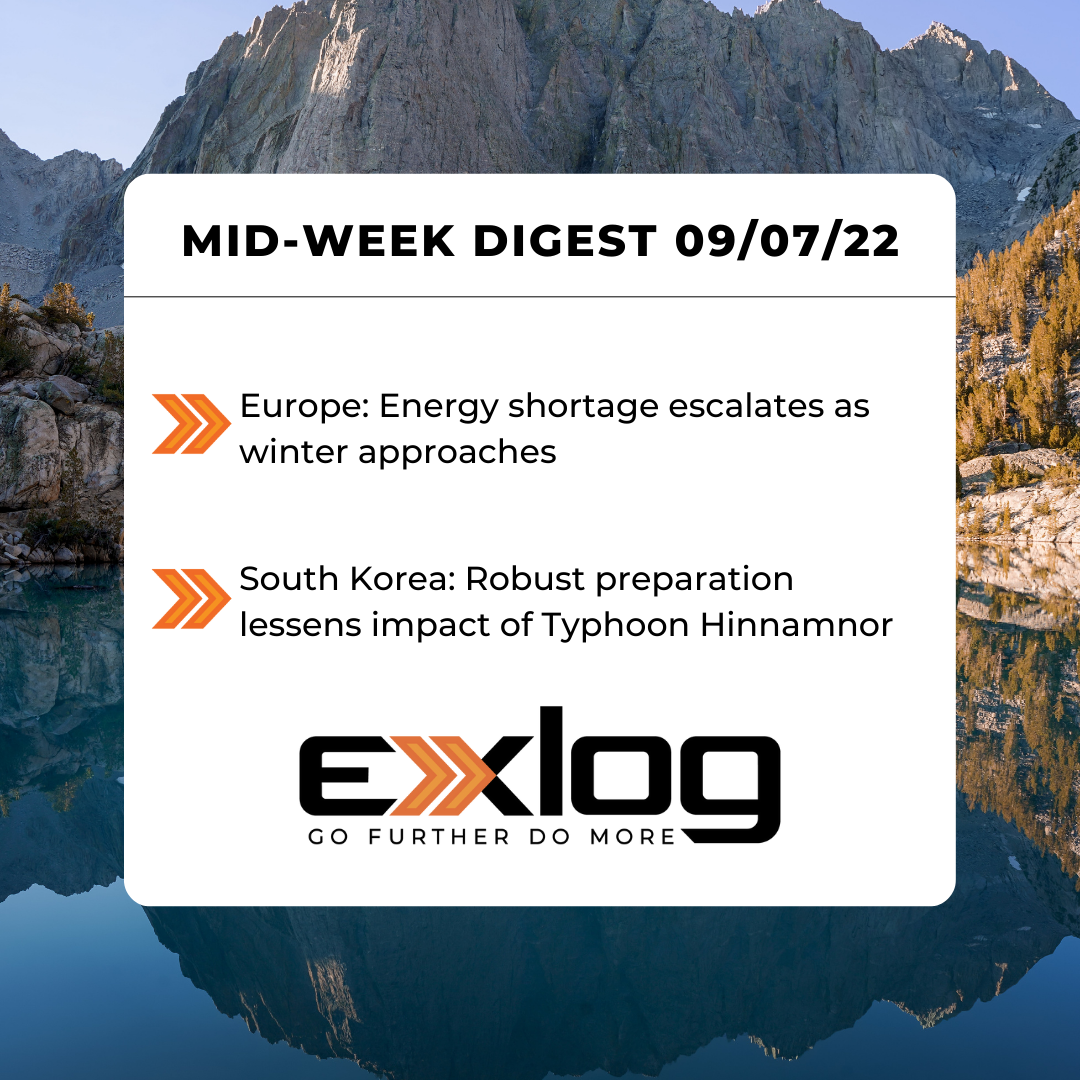europe faces worsening energy shortage and south korea largely spared damage from typhoon
Europe: Energy Shortage Escalates as Winter Approaches
Europe is struggling to cope with a worsening energy shortage linked to the ongoing war in Ukraine and exacerbated by an abnormally hot summer. European natural gas prices are now nearly USD 70 per Metric Million British Thermal Units (MMBTu), or roughly seven to ten times the US price. High costs have driven up inflation and increased costs of living, leading to labor strikes and demonstrations across the continent; as the winter season sets in, soaring prices will likely continue to fuel inflation and constrain post-COVID recovery efforts. Both supply and demand issues are contributing to Europe’s energy shortage: recent extreme weather has greatly increased demand for gas, while the continent’s supply of Russian gas (which accounts for approximately 40% of European gas imports) has been interrupted amid the war in Ukraine. Russia drastically reduced flows into Europe in response to sanctions and European support for Ukraine; the cancellation of the planned Nord Stream 2 pipeline and additional (and intentionally prolonged) maintenance of Nord Stream 1 are expected to restrict flows even more. Some countries including Germany, Italy, Austria, and the Netherlands have responded by restarting old coal power plants – forgoing concerns over carbon emissions in order to supplement shrinking energy supplies. Germany also plans to bail out its domestic energy companies, while France plans to nationalize Électricité de France S.A. (EDF) power company. Back-up energy suppliers such as Norway and North Africa have failed to fill the gap in supply, especially following recent labor strikes in the Norwegian oil and gas sector. Another challenge in the energy crisis is the lack of existing infrastructure to bring in alternative sources, such as the lack of terminals to bring in natural gas from the US shipped by tanker and the economic and time constraints of building new pipelines. Given these challenges, Europe faces an extremely difficult winter ahead marked by potential rationing, industrial shutdowns, and even economic dislocation. In the long term, Europe will likely continue to face seasonal energy shortages until it can develop the infrastructure to diversify its energy imports or achieve greater energy independence – a task that will likely take several years to complete.
South Korea: Robust Preparation Lessens Impact of Typhoon Hinnamnor
Recovery efforts are ongoing along South Korea’s southeastern coast after Typhoon Hinnamnor made landfall in the early morning hours of Sept. 6, just north of the city of Busan. At its peak, Hinnamnor was classified as a “very strong” typhoon—South Korea’s second-highest rating—registering maximum sustained winds of 90 knots (approx. 167 kph/104 mph) and bringing more than three feet of rain to the region resulting in widespread damage, especially in the cities of Pohang, Gyeongju, and Ulsan. The heavy winds and rain caused severe flooding, landslides, and roadblocks while also damaging infrastructure including the electrical grid; an estimated 66,000 homes lost power as a result of the storm, though nearly half have already had it restored. As of Wednesday evening local time, there were ten reported deaths across the storm’s impact zone, seven of which occurred in the city of Pohang, while an estimated ten more individuals were reported missing. However, casualty numbers are expected to rise in the coming days as officials gain a clearer picture of the damage and search and rescue efforts continue. The typhoon comes just four weeks after the capital city of Seoul received more than 20 inches of rain—the most in over 100 years—causing the deaths of at least 15 people as rivers flooded inundating roadways, bridges, and buildings. South Korean meteorologists cite last month’s unprecedented flooding as having catalyzed the country’s robust preparation ahead of Typhoon Hinnamnor. As the storm loomed, President Yoon Suk-Yeol placed the country on high alert for several days, initiating both proactive and reactive evacuations in high-risk areas for nearly 19,000 people, closing schools and roads, delaying the work day, readying the military to assist with rescues, and ensuring the population was aware of the storm by issuing several mobile safety warnings. These precautions, coupled with the typhoon’s rapid movement across the peninsula, significantly lessened the damage caused by the storm. Hinnamnor departed the Korean Peninsula as of 0710 local time on Sept. 6 moving east through the Sea of Japan – by late evening, the storm was 400 km northwest of northern Japan and had weakened to a tropical storm. By midday Sept. 6, recovery operations were already underway throughout the region, residents who had previously evacuated had begun to return to the area, and businesses began to reopen.


